Introduction
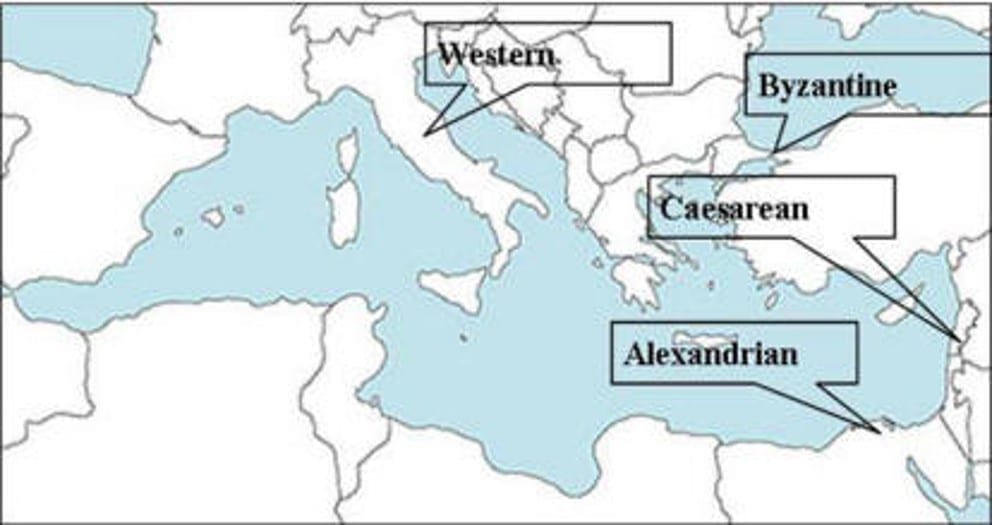 At present there are 5,656 parts of, or complete, Greek New Testament documents. No two are exactly identical.[1] However, the differences are very minor and do not involve major doctrine. Of these, about 100 of the oldest texts (written on papyrus and in uncial script, i.e. in capital letters) were discovered recently, only nine of which were found before 1900.[2] They have been classified into groups or “text-type” which is the name given to a family of texts with similar readings due to common ancestors and mutual correction. These groups of text types appear to have originated from predominantly three areas: The old Byzantine Empire, Alexandria and the Western Mediterranean area.
At present there are 5,656 parts of, or complete, Greek New Testament documents. No two are exactly identical.[1] However, the differences are very minor and do not involve major doctrine. Of these, about 100 of the oldest texts (written on papyrus and in uncial script, i.e. in capital letters) were discovered recently, only nine of which were found before 1900.[2] They have been classified into groups or “text-type” which is the name given to a family of texts with similar readings due to common ancestors and mutual correction. These groups of text types appear to have originated from predominantly three areas: The old Byzantine Empire, Alexandria and the Western Mediterranean area.
The Byzantine Text Type (also known as the Majority Text)
About 80% of all the Greek manuscripts belong to this category hence the alternative name; Majority Text. However, they are generally considered to be inferior as they date from the fourth to fourteenth centuries and most being 1,000 years from the autographs (the original writings).
Alexandrian Text Type
Documents of the Alexandrian Text Type are the earliest available and they date from the second century. Some examples follow. The earliest known fragment is Ryland’s Fragment (AD 117-138).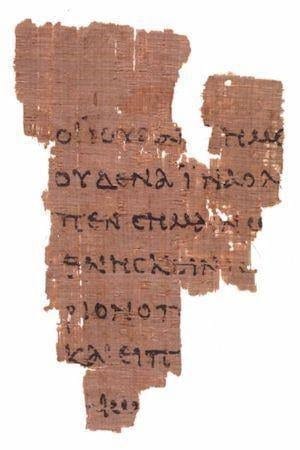 On one side is John chapter 18 verses 31-33 and on the other side is verses 37-38,
On one side is John chapter 18 verses 31-33 and on the other side is verses 37-38,
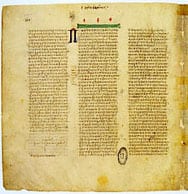 the Codex Vaticanus (a near complete OT and NT written on vellum, AD 325-350)
the Codex Vaticanus (a near complete OT and NT written on vellum, AD 325-350)
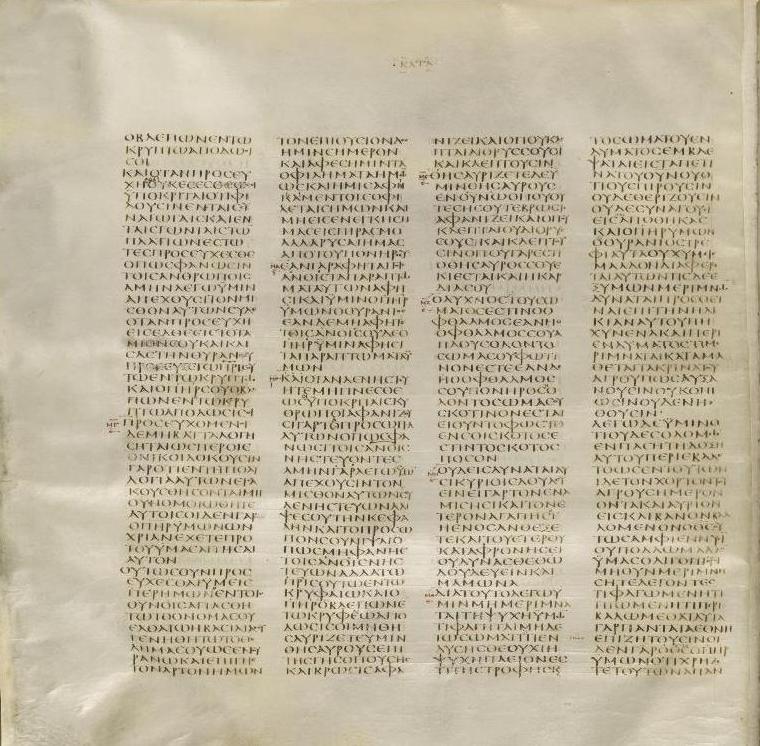 and the Codex Sinaiticus (complete NT and half of the OT, AD 340).
and the Codex Sinaiticus (complete NT and half of the OT, AD 340).
Western Text Type
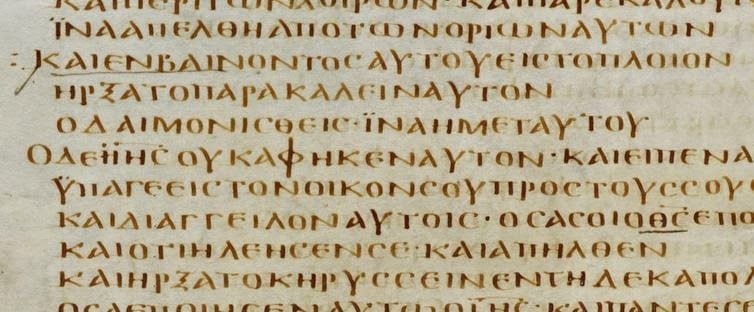 The major characteristic of the Western Text Type is its love of paraphrases: words and even clauses are changed, omitted, and inserted with surprising freedom, wherever it seemed that the meaning could be brought out with greater force and definiteness.[3] It was named “Western” by Semmler (1725-1791) because it originated in the centres of Christianity in the Western Roman Empire. Examples of this can be found in quotation from 2nd and 3rd century Christians writers. Only one Greek manuscript has been found to be of Western Text Type and this dates from the 5th century (Codex Bezae).
The major characteristic of the Western Text Type is its love of paraphrases: words and even clauses are changed, omitted, and inserted with surprising freedom, wherever it seemed that the meaning could be brought out with greater force and definiteness.[3] It was named “Western” by Semmler (1725-1791) because it originated in the centres of Christianity in the Western Roman Empire. Examples of this can be found in quotation from 2nd and 3rd century Christians writers. Only one Greek manuscript has been found to be of Western Text Type and this dates from the 5th century (Codex Bezae).
Period of Duplication (second and third centuries)
During this period the books of the NT were usually copied rather carefully by professional scribes, but sometimes hastily and imperfectly, often because of persecution. For this reason there arose a multiplicity of early variants in the text. And even though the Christian scholars at Alexandria attempted an early criticism and editing of the Greek text, the unnoticed textual errors which they inherited, plus the unintended errors which they created by editing and revisions were transmitted in the manuscripts which they ordered to be written. Thus there came into being the basis of textual problems later scholars would have to face.[4]
Translations
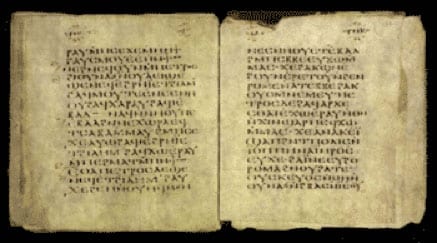 382 Jerome’s Latin Vulgate.
382 Jerome’s Latin Vulgate.
The first major translation appears to be that of Jerome. Pope Damasus 1 in AD 382 directed Jerome to compose the whole Bible into Latin. He translated the Hebrew of the Old Testament rather than the Greek (Septuagint) into Latin and made a revision of the earlier Latin translations of the New Testament which were of the Alexandrian text type. His work was completed in 405.[5] Jerome’s Vulgate (common language) was effectively the only Bible used from its inception, through the middle ages and up unto the revised translations of Erasmus. It is still used by the Roman Catholic Church. However, it was heavily slanted to some of the major doctrines of the Catholic Church; the elevations of priests and Mother Mary for example.
English translations
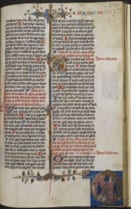 1382 Wycliffe’s Bible.
1382 Wycliffe’s Bible.
In an effort to enable lay people to be able to read the scriptures and to be able to compare the lifestyles of the clergy with what the scriptures say, John Wycliffe (1330-1384) translated, with the help of a team of scribes, the Bible into English. However, his translation was from Jerome’s vulgate with all of its inherent errors. Wycliffe died before the “church” could kill him.
1450s Johann Gutenberg developed the printing press with movable type and in doing so created an explosion in books.
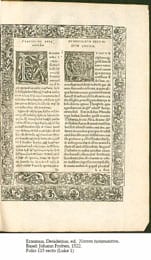 1516 Textus Receptus.
1516 Textus Receptus.
Dutch scholar and prolific writer, Desiderius Erasmus (Erasmus of Rotterdam) (1465-1530) was so grieved by the errors in Jerome’s Latin Vulgate that he decided to produce his own version of the scriptures (NT), in Latin, but this time from the Greek. Apparently his publisher (Johann Froben of Basel) urged him to produce a Greek version as well, since none was in existence. He hurriedly did this and in 1516 his Latin and Greek translations were published side by side. However, he did this work from only seven incomplete Greek manuscripts and these were of the Majority Text Type (Byzantine) and all dated from the eleventh to the fourteenth centuries. The combination of these Greek documents did not comprise the entire New Testament so Erasmus back translated the last six verses of The Revelation from Latin to Greek.[6] Unfortunately even these last six verses contained an error which is still present in the King James Bible of today.[7] Erasmus produced four editions of his Greek NT and later scholars continued with the changes, the last by Elziver in 1650. It was Elziver’s second edition of 1633 that was called the Received Text or Textus Receptus.
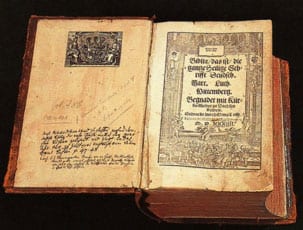 1522 Luther’s German Bible.
1522 Luther’s German Bible.
After Luther nailed his 95 theses to the church door at Wittenberg and as a consequence upset the Pope and was hiding in the Wittenberg castle, he translated the NT into German from Erasmus’s 1519 second edition,[8] of his Greek translation in 1522 and the OT in 1534.
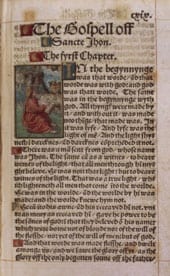 1526 Tyndale’s New Testament.
1526 Tyndale’s New Testament.
Using Erasmus’ Greek New Testament, William Tyndale (1492-1536) published the NT in English and therefore different to Wycliffe’s which was based on Jerome’s Latin Vulgate. Tyndale produced a revised edition in1534. The term Tyndale’s Bible is not strictly correct, because Tyndale never published a complete Bible. That task was completed by Miles Coverdale, who supplemented Tyndale’s translations with his own to produce the first complete printed Bible in English in 1535. Before his execution, Tyndale had translated the New Testament, the Pentateuch, and the historical books of the Old Testament. Of the Old Testament books, the Pentateuch, Jonah, and a revised version of Genesis were published during Tyndale’s lifetime. His other Old Testament works were first used in the creation of the Matthew Bible and also greatly influenced subsequent English translations of the Bible. Many of the expressions which are associated with the King James Bible were introduced by Tyndale. For his work, he was strangled and burnt at the stake in 1536.
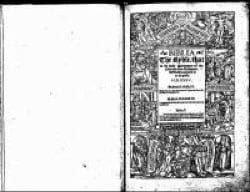 1535 The Coverdale Bible.
1535 The Coverdale Bible.
Myles Coverdale produced the first complete English Bible. His work was based on Tyndale’s New Testament and Pentateuch as well as two Latin translations: Jerome’s Vulgate and that of Italian scholar; Sancte Pagnini. Coverdale’s translation is not really a translation in itself but rather a compilation of other people’s translations.[9]
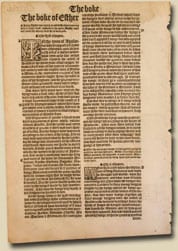 1537 The Matthew Bible.
1537 The Matthew Bible.
The Matthew Bible was first published in 1537 by John Rogers, under the pseudonym “Thomas Matthew”. It combined the New Testament of William Tyndale with Myles Coverdale’s Bible. John Rogers was later captured and put to death in 1555 under the reign of Mary Tudor.
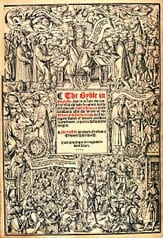 1539 The Great Bible (second and most popular printing; 1540).
1539 The Great Bible (second and most popular printing; 1540).
The Great Bible was the first authorized edition of the Bible in English, authorized by King Henry VIII of England to be read aloud in the church services of the Church of England. This happened of course, after Henry broke from the Roman church and established his own (Church of England) of which he declared himself head. It was prepared by Miles Coverdale, working under commission of Sir Thomas Cromwell and it was designed very large for reading in churches only.
1560 The Geneva Bible.
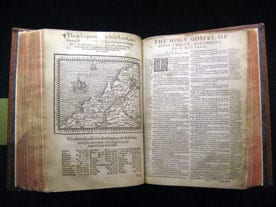 Many Protestants were exiled under the reign of the Roman Catholic queen Mary Tudor (1553-1558). Several notable Bible scholars took refuge in Geneva. John Knox, John Calvin and Myles Coverdale were among them. This group of English exiles was led by William Whittingham who had already revised the New Testament text of the Matthew Bible and they produced the Geneva Bible. It is one of the most historically significant translations of the Bible into the English language, preceding the King James translation by 51 years. It was the primary Bible of the 16th century protestant movement and was the Bible used by William Shakespeare, Oliver Cromwell, John Milton, John Knox, John Donne, and John Bunyan, author of Pilgrim’s Progress. It was one of the Bibles taken to America on the Mayflower. It was the first English Bible where the OT was translated from the original Hebrew. The NT was mostly from the works of Tyndale and Coverdale, which in turn, were based on Erasmus’ Textus Receptus.
Many Protestants were exiled under the reign of the Roman Catholic queen Mary Tudor (1553-1558). Several notable Bible scholars took refuge in Geneva. John Knox, John Calvin and Myles Coverdale were among them. This group of English exiles was led by William Whittingham who had already revised the New Testament text of the Matthew Bible and they produced the Geneva Bible. It is one of the most historically significant translations of the Bible into the English language, preceding the King James translation by 51 years. It was the primary Bible of the 16th century protestant movement and was the Bible used by William Shakespeare, Oliver Cromwell, John Milton, John Knox, John Donne, and John Bunyan, author of Pilgrim’s Progress. It was one of the Bibles taken to America on the Mayflower. It was the first English Bible where the OT was translated from the original Hebrew. The NT was mostly from the works of Tyndale and Coverdale, which in turn, were based on Erasmus’ Textus Receptus.
The Geneva Bible was the first Bible to add numbered verses to the chapters, so that referencing specific passages would be easier. Every chapter was also accompanied by extensive marginal notes which later were a source of annoyance to King James and the established Anglican Church.
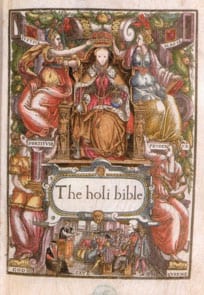 1558 The Bishop’s Bible.
1558 The Bishop’s Bible.
The Bishops’ Bible is an English translation of the Bible which was produced under the authority of the established Church of England in 1568. The thorough Calvinism of the Geneva Bible displayed in the marginal notes more so than in the translation itself, offended the High-Church party of the Church of England, to which almost all of its bishops subscribed. They associated Calvinism with Presbyterianism, which sought to replace government of the church by bishops (Episcopalian) with government by lay elders (presbytery). It was substantially revised in 1572, and this revised edition was to be prescribed as the base text for the Authorized King James Version of 1611.
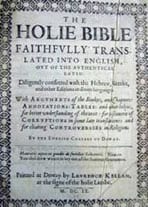 1585 Rheims New Testament.
1585 Rheims New Testament.
This is an English version of Jerome’s Latin Vulgate containing all of the corruption that Erasmus removed. It was followed in 1609 by the OT in English. The combination became known as the Doway/Rheims Version.
1611 The King James Bible.
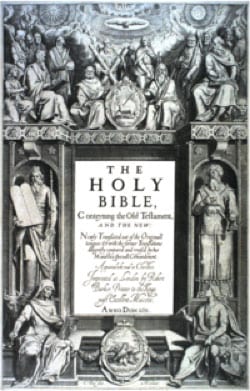 When James took the throne of England, the Geneva Bible was very popular especially amongst the Protestants and Puritans. However, James and the established church (Anglican) disliked its marginal notes which did not support church hierarchy with the king at the top, so James ordered a new translation to be produced but it had to be based on the Bishop’s Bible. An assembly of men skilled in Greek, Hebrew, Latin and other languages produced a Bible which the King authorised and was the Bible to be used in all churches. This became known as the King James Bible or The Authorised Version. It became the most printed book in the world with over one billion copies produced and was the main Bible for over 250 years. All KJV Bibles purchased today are not the 1611 version (it is very difficult to read) but the 1769 Baskerville spelling and wording revision of the 1611. The Apocrypha (the Apocrypha are inter-testament books written before Christ and are considered as being non-canonical) was officially removed from the KJV in 1815 leaving only the 66 books.
When James took the throne of England, the Geneva Bible was very popular especially amongst the Protestants and Puritans. However, James and the established church (Anglican) disliked its marginal notes which did not support church hierarchy with the king at the top, so James ordered a new translation to be produced but it had to be based on the Bishop’s Bible. An assembly of men skilled in Greek, Hebrew, Latin and other languages produced a Bible which the King authorised and was the Bible to be used in all churches. This became known as the King James Bible or The Authorised Version. It became the most printed book in the world with over one billion copies produced and was the main Bible for over 250 years. All KJV Bibles purchased today are not the 1611 version (it is very difficult to read) but the 1769 Baskerville spelling and wording revision of the 1611. The Apocrypha (the Apocrypha are inter-testament books written before Christ and are considered as being non-canonical) was officially removed from the KJV in 1815 leaving only the 66 books.
1881 The New Testament in the Original Greek.
Up to this point, most English language Bibles contained the 14 Apocryphal books and were based on Erasmus’ Greek New Testament; a revised New Testament which relied heavily but not exclusively, on two fourth century manuscripts; Codex Vaticanus[10] and Codex Sinaiticus[11] (discovered only in 1859. For more on its discovery go to: https://www.adefenceofthebible.com/2017/03/14/tischendorfs-great-manuscript-find.) was produced by Brooke Foss Westcott and Fenton John Anthony Hort: The New Testament in the Original Greek. Westcott and Hort distinguished four text types in their studies. The most recent is Syrian, or Byzantine text-type, of which the newest example, thus from the critical text view, less reliable, is the Textus Receptus. The Western text-type is much older, but tends to paraphrase, so according to them also lacks dependability. The Alexandrian text-type, exemplified in the Codex Ephraemi, exhibits a polished Greek style. The two scholars identified their favorite text type as “Neutral text”, exemplified by the two 4th century manuscripts Codex Vaticanus (known to scholars since the 15th century) and Codex Sinaiticus (discovered only in 1859), both of which they relied on heavily but not exclusively for this edition. This text has only a few changes of the original. This edition is based on the critical works especially of Tischendorf and Tregelles. The minuscules play a minimal role in this edition.[12]
Bible critic Bruce Metzger said in 1981:
The international committee that produced the United Bible Societies Greek New Testament, not only adopted the Westcott and Hort edition as its basic text, but followed their methodology in giving attention to both external and internal consideration.
New Testament scholar Philip W Comfort gave this opinion:
The text produced by Westcott and Hort is still to this day, even with so many more manuscript discoveries, a very close reproduction of the primitive text of the New Testament.
Most of the modern versions of the Bible are based on Westcot and Hort’s Greek New Testament.
1963-2012 Novum Testamentum Graece
Today the designation Novum Testamentum Graece normally refers to the Nestle-Aland editions of the New Testament in Greek. In 1952 Erwin Nestle continued the work of his father Eberhard, in composing a Greek New Testament based on, but not entirely on, the oldest existing texts (Alexandrian Text Type). Kurt Aland joined Erwin Nestle. Aland submitted his work to the editorial committee of the United Bible Societies Greek New Testament of which he was also a member. It became the basic text of their third edition (UBS3) in 1975, four years before it was published as the 26th edition of Nestle-Aland.[13] Subsequent editions are continuously up dated using the eclecticism method.[14]
The Nestle-Aland text is the primary source for most contemporary New Testament translations, although most are translations of the earlier text that was available at the time of translation. The Nestle-Aland text is also the standard for academic work in New Testament studies.
Conclusion
Apart from the KJV and the NKJV which contain a New Testament translated from a small part of the Byzantine (Majority Text), neally all modern versions of the Bible have their New Testament translated predominantly from the Alexandrian Text type using the technique of eclecticism. As a consequence of their different sources, modern versions do not contain the extra words and sentences found in the KJV.
[1] Roy E. Beacham and Kevin T. Bauder, One Bible Only? Examining the Exclusive Claims for the King James Bible, Kregel, Grand Rapids, 2001, page 76.
[2] Ibid, page 77
[3] Wikipedia, Western Text Type quoting B. F. Westcott and F. J. A. Hort, The New testament in The Original Greek, 1925, page 550.
[4] Wycliffe Bible Dictionary, Hendrickson, Massachusetts, 1998, page 255.
[5] Wikipedia, Jerome’s Latin Vulgate.
[6] Roy E. Beacham and Kevin T. Bauder, One Bible Only? Examining the Exclusive Claims for the King James Bible, Kregel, Grand Rapids, 2001, page 82; Ron Rhodes, The Complete Guide to Bible Translations, Harvest House Publishers, Eugene Oregon, 2009, page 228.
[7] Revelation 22:19 states “book of life” whereas all earlier Greek documents have “tree of life”
[8] wikipedia.org/wiki/Desiderius_Erasmus
[9] Alister McGrath, In The Beginning. The Story of the King James Bible and how it changed a Nation, Language and a Culture, Hodder & Stoughton, London, 2001, pages 89-90.
[10] The Codex Vaticanus is one of the oldest extant manuscripts of the Greek Bible (both the Old and New Testaments), one of the four great uncial codices. The Codex is named after its place of conservation in the Vatican Library, where it has been kept since at least the 15th century. It is written on 759 leaves of vellum in uncial letters and has been dated palaeographically to the 4th century.
The manuscript became known to Western scholars as a result of correspondence between Erasmus and the prefects of the Vatican Library. The Codex’s relationship to the Latin Vulgate was unclear and scholars were initially unaware of the Codex’s value. This changed in the 19th century when transcriptions of the full codex were completed. It was at that point that scholars realised the text differed significantly from the Vulgate and the Textus Receptus.
Current scholarship considers the Codex Vaticanus to be one of the best Greek texts of the New Testament, with the Codex Sinaiticus as its only competitor. Until the discovery by Tischendorf of the Sinaiticus text, the Codex was unrivaled. It was extensively used by Westcott and Hort in their edition of The New Testament in the Original Greek in 1881. The most widely sold editions of the Greek New Testament are largely based on the text of the Codex Vaticanus (http://en.wikipedia.org/wiki/Codex_Vaticanus).
[11] Codex Sinaiticus is one of the four great uncial codices, an ancient, handwritten copy of the Greek Bible. The codex is considered a priceless historical treasure.
The codex is an Alexandrian text-type manuscript written in the 4th century in uncial letters on parchment. Current scholarship considers the Codex Sinaiticus to be one of the best Greek texts of the New Testament, along with that of the Codex Vaticanus. Until the discovery by Tischendorf of the Sinaiticus text, the Codex Vaticanus was unrivaled.
The Codex Sinaiticus came to the attention of scholars in the 19th century at the Greek Orthodox Monastery of Mount Sinai, with further material discovered in the 20th and 21st centuries. Although parts of the Codex are scattered across four libraries around the world, most of the manuscript today resides within the British Library. Since its discovery, study of the Codex Sinaiticus has proven to be extremely useful to scholars for the purposes of biblical translation.
Originally, the Codex contained the whole of both Testaments. Approximately half of the Greek Old Testament (or Septuagint) survived, along with a complete New Testament, plus the Epistle of Barnabas, and portions of The Shepherd of Hermas (http://en.wikipedia.org/wiki/Codex_Sinaiticus).
[12]http://en.wikipedia.org/wiki/The_New_Testament_in_the_Original_Greek
[13]http://en.wikipedia.org/wiki/Novum_Testamentum_Graece
[14] Eclecticism refers to the practice of consulting a wide diversity of witnesses to a particular original. The practice is based on the principle that the more independent transmission histories are, the less likely they will be to reproduce the same errors. What one omits, the others may retain; what one adds, the others are unlikely to add. Eclecticism allows inferences to be drawn regarding the original text, based on the evidence of contrasts between witnesses.
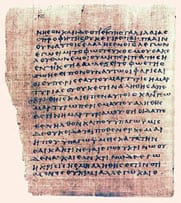


1 Comment. Leave new
Thanks for bringing clarity to an often unclear and confusing topic.